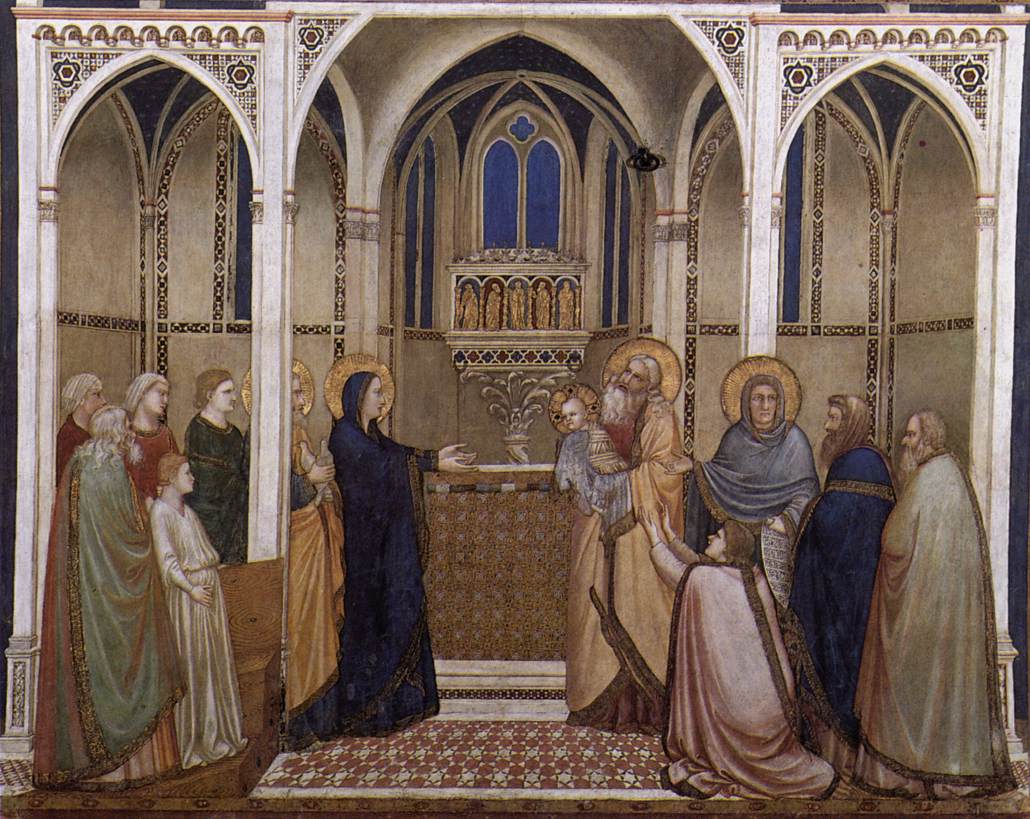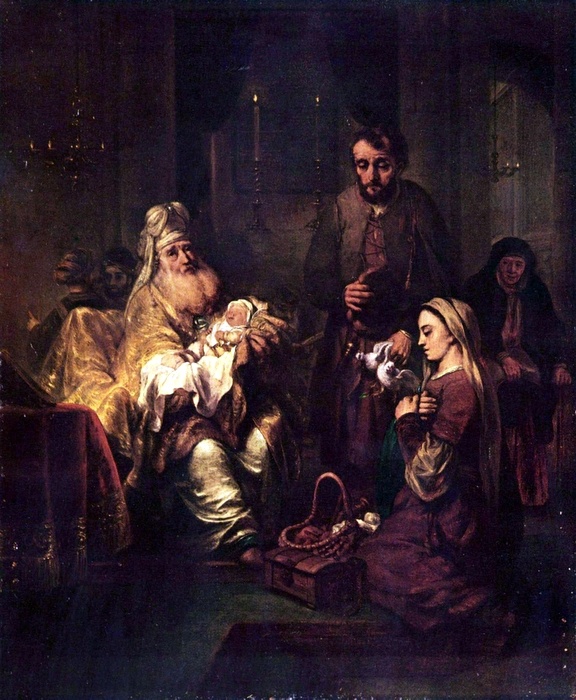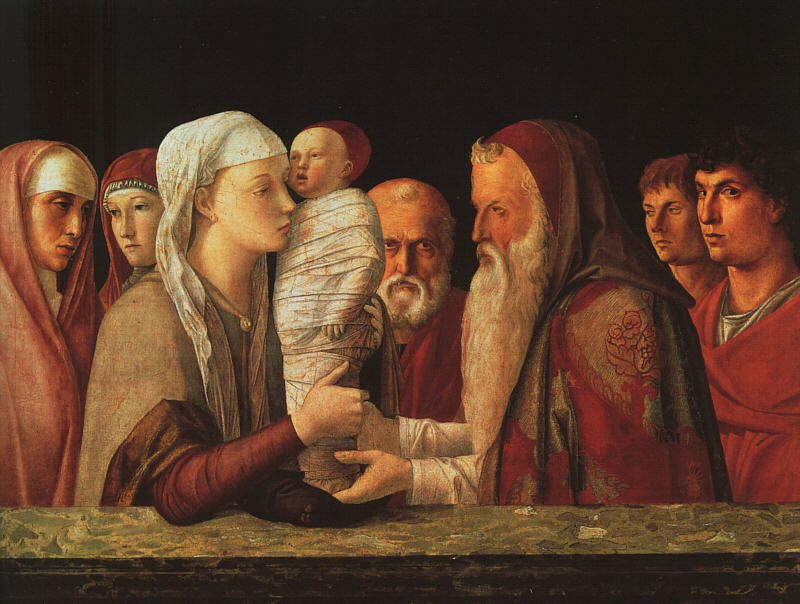Today I took the kids to our homeschooling group’s annual Lenten retreat. The theme of this year’s retreat was The Seven Sorrows of Mary. A young priest, Fr. Anthony Cusak, (himself a homeschool graduate) gave a meditation for the mothers that was just beautiful. As he spoke of the Flight into Egypt he referenced a painting at the MFA (more about that painting in my next post about the Flight into Egypt). I knew I needed to go look up the painting and also that I needed to go look up art to go with all the sorrows and to post them here with some of what I remember from his talk and some of my own thoughts and reflections. So here is the first of a planned series of seven posts.

Fresco San Francesco, Assisi.
A sword will pierce your soul too
Simeon blessed them and said to Mary his mother, ‘Behold, he is destined for the fall and for the rise of many in Israel, destined to be a sign that is opposed- and a sword will pierce your soul too — so that the secret thoughts of many may be laid bare.’ – Luke 2:34-35.
To me this one is at first rather baffling. Being told that she will have sorrow is itself one of Mary’s sorrows. Simeon’s prophecy about the sword is itself a sword. She is transfixed. She grieves the loss future of the child who has only just been born. The weight of his suffering presses on the new mother, the weight of all our sins.
In Giotto’s image (above) Mary reaches out towards her child in Simeon’s hands. She looks sorrowful, her face distressed. A dark figure placed between the gold of Joseph and the gold of Simeon. Her iconic blue robes so dark that she already seems to be in mourning. The mother bereft of her baby seeking to clutch him to her breast. Here she seems to prefigure the the mothers of the slain innocents who Herod will put to the sword. She prefigures the panicked mother who loses her child on the way home from Jerusalem and finds him days later in the Temple. She prefigures the sorrowful mother at the foot of the cross and the mother who will lay her child in the tomb.
But here, now, she extends her hands in a gesture universal to all mothers. Here, give him to me, she seems to say. The gesture a mother makes when someone else is holding the baby and he begins to cry. Let me hold him. She longs to comfort him. Or maybe to find comfort in his embrace. But this baby is not crying. He looks calmly across the space that separate him from his mother. He is not distressed. Already he seems to be giving her the message he will articulate when she finds him teaching in the Temple, Do you now know I must be about my Father’s work?
(Incidentally, I love Giotto’s placement of St Joseph behind the pillar. St Joseph who never speaks a word in any of the Gospels. St Joseph who we only seem to see in part, hidden in the shadows.)

Gerbrand van den Eeckhout
In Eeckhout’s painting Mary kneels while the Christ Child is enthroned upon Simeon’s lap, a reversal of the usual scene of the Madonna and Child where Mary forms the throne and saints kneel to adore the child seated on her lap. Here, Mary is the adorer, her hands folded on her breast. She looks humble and prayerful, her eyes cast down. But she doesn’t seem particularly sorrowful. She seems perfectly peaceful. Joseph stands behind her, cap in hand, with the sacrificial doves in his hand. Both of them are simply dressed, peasant rather than robed in rich finery. And yet here, too, though she does not look sad or distressed, she is still separated from her child. He is set apart, the light and the rich gold fabric of Simeon’s robes emphasizing his divinity and his role as Light to the Nations.

And then there’s Bellini. Mary calmly meets Simeon’s gaze as she hands over the tightly swaddled Christ Child into his arms. Actually, Simeon reaches for the infant with outstretched hands that seem to plead while Mary’s hands firmly holding the baby look like she’s almost holding the baby back. Her calm eyes almost seem to challenge Simeon: Take my baby, but I’m watching you. I can’t quite tell is her gaze is that of a fierce or gentle mother; fierce but gentle, perhaps. (Isabella says “determined” and I think that’s a good word.) Docile and yet not to be messed with. (Joseph in the background positively glowers at Simeon. Jesus, with his open mouth, looks like he’s about to latch on to Mary’s nose or her eyebrow.)
Although her protective stance perhaps does tell of her awareness of the shadow approaching, in this painting what mainly strikes me as pointing to Mary’s sorrow is the wrappings on the baby. Jesus’s swaddling bands look like a shroud. He’s a little mummy with just his face uncovered and the fingers of his hand peeking out. This certainly seems to foretell the tomb.
What did Mary know of God’s plan? How much did she understand in that moment when Simeon foretold a sword? We can never know for certain. But we do know that she pondered these words– and other words and other deeds– in her heart. And as she pondered did the words themselves turn into daggers, piercing her heart as she looked ahead to what was coming?
If you knew for certain that your child would die, that you would outlive him, how would you bear that knowledge? Just recently Dom and I watched Arrival, in which a mother faces just that scenario, the terrible death of her child. It is every parent’s worst nightmare to bury their child. And yet Mary bore that pain quietly through all the long years of his growing.


[…] On Friday I took the kids to our homeschooling group’s annual Lenten retreat. The theme of this year’s retreat was The Seven Sorrows of Mary. A young priest, Fr. Anthony Cusak, (himself a homeschool graduate) gave a meditation for the mothers that was just beautiful. As he spoke of the Flight into Egypt he referenced a painting at the MFA. I knew I needed to go look up the painting and also that I needed to go look up art to go with all the sorrows and to post them here with some of what I remember from his talk and some of my own thoughts and reflections. So here is the second of a planned series of seven posts. See the first here: The Prophecy of Simeon . […]
[…] and reflections. So here is the second of a planned series of seven posts. See the first here: The Prophecy of Simeon and the second: Flight into […]
[…] my own thoughts and reflections. So here is the fourth of a planned series of seven posts: First: The Prophecy of Simeon, second: Flight into Egypt, third: The Loss of the Child Jesus in the […]
[…] my own thoughts and reflections. So here is the fourth of a planned series of seven posts: First: The Prophecy of Simeon, second: Flight into Egypt, third: The Loss of the Child Jesus in the Temple, fourth: Meeting Jesus […]
[…] my own thoughts and reflections. So here is the fourth of a planned series of seven posts: First: The Prophecy of Simeon, second: Flight into Egypt, third: The Loss of the Child Jesus in the Temple, fourth: Meeting Jesus […]
[…] my own thoughts and reflections. So here is the fourth of a planned series of seven posts: First: The Prophecy of Simeon, second: Flight into Egypt, third: The Loss of the Child Jesus in the Temple, fourth: Meeting Jesus […]